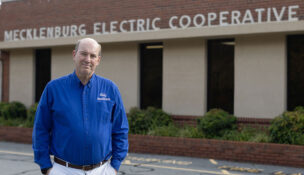Wind at their backs
Region closes in on becoming offshore wind hub
Wind at their backs
Region closes in on becoming offshore wind hub
Hampton Roads is on the cusp of becoming a supply chain hub for the thousands of components used to construct the massive turbines that will propel offshore wind farms being developed off the East Coast.
American offshore wind projects currently rely on a European supply chain for turbine components, but shipping the enormous turbines, blades and foundations overseas is expensive, time-consuming and even risky. So, Atlantic seaboard states are looking to cut out the middleman and develop a new U.S. industry, with Virginia and Hampton Roads leading the way.
Hampton Roads boasts a deep, wide harbor free of air-draft restrictions posed by bridges and other overhead structures, an abundance of terminal facilities and waterfront sites and a large, skilled maritime workforce supporting the nation’s largest shipbuilding industry. Plus, Virginia’s pro-business incentives include lower taxes and labor costs and fewer regulations than other East Coast states.
“It’s a generational opportunity to change the economics of Hampton Roads and maybe even Virginia,” says Matt Smith, director of offshore wind business development for the Hampton Roads Alliance. “We’re starting from scratch and trying to build an industry in the U.S. that doesn’t exist yet.”
Generating jobs
The components used in the massive turbines, including blades, generators and foundations, as well as the cables connecting the turbines and substations to shore, could be produced in Hampton Roads and shipped to projects up and down the East Coast. “Our goal is to have as many local businesses participate and be in a place where the industry can locate for the long term,” Smith says.
According to an economic impact analysis that Glen Allen-based Mangum Economics conducted for the alliance, the offshore wind industry will support approximately 5,200 jobs in Virginia — primarily in Hampton Roads — as businesses help develop one gigawatt of new offshore wind energy annually. Those jobs would equal $270 million in pay and benefits, with
$740 million in total economic impact.
Mangum also estimates that construction of Dominion Energy Inc.’s 2.6-gigawatt Coastal Virginia Offshore Wind project will support roughly 900 jobs, with about 60% in Hampton Roads, leading to more than $143 million in economic output. Once construction is completed in 2027, more than 1,100 workers in Hampton Roads would operate and maintain the wind farm. That could translate into $210 million in economic output for the region, generating nearly
$6 million in local tax revenue.
“This is a game-changer industry for the region,” says Doug Smith, president and CEO of the Hampton Roads Alliance. “If we get more and more of these wind farms permitted along the East Coast, opportunities for companies to come along and make significant investments in Virginia are enhanced.”
In March, the White House announced a $3 billion program to expand offshore wind energy and deploy 30 gigawatts of offshore wind by 2030, speeding up approval of projects off the Atlantic Coast, such as Dominion Energy’s wind farm. Also in the plan are port upgrades and opening an area between Long Island and the New Jersey coast as a priority site for offshore wind development, although a Dominion spokesperson says that the utility does not see this as a disadvantage to Virginia.
With the installation of two test turbines in federal waters last summer, Dominion Energy has emerged as a leader in the offshore wind industry. Construction on its commercial offshore wind operation, the largest in the nation, is scheduled to start in 2024 and is expected to generate power for approximately 650,000 homes.
“This project is a good anchor to attract businesses to Virginia,” says Mark Mitchell, Dominion’s senior vice president of project construction. “Virginia has all the makings of becoming a support not only for our project but for other projects in the Northeast.”
Dominion has invested $500 million in a 472-foot-long, 184-foot-wide vessel to carry and install the turbines, foundations and other heavy components needed for the vast wind farm. It will be the nation’s first offshore wind vessel in compliance with the Jones Act, which requires goods shipped between U.S. ports to be carried on American-built ships. Now under construction in Brownsville, Texas, the ship, named Charybdis after the sea monster from Greek mythology, will operate out of Hampton Roads when it goes into service in late 2023.
“There are a very limited number of these huge vessels in the world,” Mitchell adds. “No vessel in the U.S. can currently install wind turbines, so this vessel is a very critical piece for the entire offshore supply chain in the U.S.”
Supply chain sparks
Spain-based Siemens Gamesa Renewable Energy S.A., which is supplying the wind turbines for Dominion’s commercial project, has expressed interest in building a factory in Hampton Roads that would produce fiberglass blades for turbines. “We could see different components manufactured in different ports,” Mitchell says. “We could have a blade factory in Virginia, while the foundations could be manufactured in New Jersey.”
The Hampton Roads Alliance and Dominion have been hosting monthly online forums to educate local businesses about the nascent industry’s supply chain needs. More than 300 companies attended the first forum in December.
Scores of local maritime companies are already supporting offshore wind by performing surveying, geotechnical work, and vessel and terminal operations for Dominion’s venture, says Will Fediw, vice president of industry and government affairs for the Virginia Maritime Association.
However, specialized firms that manufacture turbines and blades will need to be established. “That supply chain needs to be built, but I think we’re close,” Fediw says. “We’re getting there and moving in concert with the projects’ permitting schedules.”
Jennifer Palestrant, chief deputy for the Virginia Department of Mines, Minerals and Energy, says her phone has been ringing off the hook with calls from companies interested in contributing to the offshore wind supply chain.
“It’s a perfect marriage into the existing maritime industry,” says Palestrant, who oversees the development of offshore wind on the state level. “There are very similar skillsets, and a lot of the industry contained in shipbuilding and repair can play a role in offshore wind.”
Denmark-based Ørsted, one of the world’s largest wind-energy developers, is already leasing part of Portsmouth Marine Terminal from the Port of Virginia to stage materials and equipment for its offshore wind endeavors in six states. Ørsted ships equipment to PMT to be worked on and transported to the offshore sites for installation.
Palestrant notes one major challenge to Virginia’s maritime growth: replacing retiring workers.
The state recently launched the Mid-Atlantic Training Alliance at Virginia Beach’s Centura College, the Mid-Atlantic Maritime Academy and Martinsville’s
New College Institute, and offers Global Wind Organisation-required certifications to operate and maintain wind projects.
(See related story, Page 28)
“Many roles are needed in this industry,” notes John Larson, Dominion’s director of public policy and economic development. For example, the turbines in the utility’s CVOW project will include 190 elevators. “Those elevators will need to be maintained and repaired over the life of the turbines, so we will need a company with employees trained to work offshore and at those heights.”
t
















